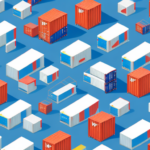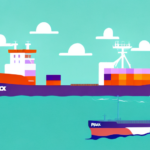Understanding International Economy Shipping
International economy shipping is a widely used method for transporting goods across borders. It is favored for non-urgent shipments such as documents, small packages, and low-value merchandise. This shipping option provides a cost-effective solution for businesses and individuals looking to send items without the need for expedited delivery.
Definition and Overview
International economy shipping involves the transportation of goods using slower, more economical methods compared to express or priority shipping. Typically, this method utilizes sea freight or consolidated air freight, which allows for lower shipping costs by sharing container space among multiple shipments.
Typical Uses
This shipping method is ideal for:
- Bulk shipments of non-perishable goods
- Documents and paperwork
- Small consumer items like books, clothing, and toys
Factors Affecting Shipping Time
Several elements influence the duration of international economy shipping:
Origin and Destination Logistics
The distance between the shipping origin and destination plays a significant role. Shipping from a developed country with advanced infrastructure to a developing country with limited transportation networks can result in longer transit times.
Mode of Transportation
Choosing between sea and air freight affects shipping time. While sea freight is more cost-effective for larger shipments, it generally takes longer than air freight. Conversely, air freight is faster but comes at a higher cost, making it suitable for time-sensitive or perishable goods.
Customs and Regulations
Each country has its own customs clearance procedures, which can cause delays if not properly managed. Proper documentation and compliance with local regulations are essential to minimize delays at customs checkpoints.
Carrier Networks and Routes
The efficiency and reach of a carrier's network influence delivery times. Carriers with extensive global networks and optimized shipping routes can offer faster and more reliable shipping services.
Weather Conditions
Adverse weather conditions, such as storms or hurricanes, can disrupt shipping schedules, leading to unexpected delays.
Calculating and Managing Shipping Time
Estimating and managing shipping times requires careful consideration of various factors to ensure timely delivery.
Methods to Estimate Shipping Time
To calculate the estimated shipping time, consider the following:
- Shipping Method: Sea freight typically takes 4-6 weeks, while air freight can take 3-7 days.
- Carrier: Different carriers offer varying transit times based on their service levels and routes.
- Origin and Destination: Longer distances naturally result in longer shipping durations.
- Customs Clearance: Allow extra time for customs processing, especially for shipments with complex documentation.
Tracking and Visibility
Many carriers provide tracking services that allow customers to monitor their shipments in real-time. This visibility helps in managing expectations and planning accordingly.
Managing Delays
Delays can occur due to unforeseen circumstances. To manage them effectively:
- Maintain clear communication with customers about potential delays.
- Offer alternatives or compensations, such as discounts on future shipments.
- Work closely with carriers to identify and resolve issues promptly.
Pros and Cons of International Economy Shipping
Weighing the advantages and disadvantages helps businesses determine if this shipping method aligns with their needs.
Advantages
- Cost-Effective: Significantly lower shipping costs compared to expedited methods.
- Environmental Benefits: Consolidated shipments can reduce the overall carbon footprint.
- Ideal for Non-Urgent Shipments: Suitable for items that do not require immediate delivery.
Disadvantages
- Longer Transit Times: Delivery can take several weeks, which may not be acceptable for time-sensitive goods.
- Reduced Tracking Accuracy: Some carriers may offer limited tracking updates.
- Potential for Delays: Increased likelihood of delays due to multiple handling points and customs clearance.
Cost vs. Speed
Businesses must balance the need for cost savings with the requirement for timely delivery. While economy shipping reduces expenses, it requires careful planning to ensure that longer transit times do not adversely affect operations or customer satisfaction.
The Role of Customs in Shipping Times
Customs procedures are critical factors in international shipping that can significantly impact delivery times.
Customs Clearance Procedures
Each country has specific requirements for importing goods. Proper documentation, including invoices, certificates of origin, and import licenses, is essential to facilitate smooth customs clearance.
Duties and Taxes
Customs may impose duties and taxes based on the value and type of goods being shipped. Understanding these costs upfront helps in accurate pricing and avoiding unexpected expenses.
Compliance and Regulations
Non-compliance with customs regulations can lead to shipment seizures, fines, or prolonged delays. Working with experienced customs brokers can help navigate these complexities.
Managing Shipping Delays
Despite meticulous planning, shipping delays can occur. Effective management strategies are crucial to mitigate their impact.
Effective Communication
Keeping customers informed about the status of their shipments fosters trust and reduces frustration. Regular updates via email or the carrier’s tracking system are essential.
Offering Compensation
Providing options such as discounts on future shipments or partial refunds can help maintain customer satisfaction in the event of delays.
Carrier Collaboration
Maintaining strong relationships with reliable carriers ensures quicker resolution of issues that may arise during shipping, thereby minimizing delays.
Comparing Different Carriers
Choosing the right carrier is pivotal for optimizing shipping times and costs.
Major Carriers
Key players in the international economy shipping market include:
- FedEx: Known for its extensive global network and reliable services.
- UPS: Offers a range of shipping options with robust tracking capabilities.
- DHL: Specializes in international shipping with a strong presence in Europe and Asia.
Carrier Performance Metrics
When comparing carriers, consider the following metrics:
- Transit Time: The duration from shipment origin to destination.
- Delivery Reliability: Consistency in on-time deliveries.
- Cost: Total shipping expenses including any additional fees.
- Customer Support: Availability and responsiveness of customer service.
Tips for Reducing Shipping Time
Implementing best practices can help shorten international economy shipping times.
Proper Packaging and Labeling
Ensuring that packages are well-packaged and correctly labeled minimizes the risk of damage and prevents delays during handling and customs inspections.
Choosing the Right Carrier
Select carriers with proven track records for reliability and efficiency in international shipping. Reviewing carrier performance data can aid in making informed decisions.
Staying Updated with Customs Requirements
Regularly updating knowledge of customs regulations and requirements helps in preparing accurate documentation, thereby avoiding unnecessary delays.
Future Trends and Predictions
The landscape of international economy shipping is continually evolving, driven by technological advancements and changing market demands.
Technological Advancements
Innovations such as blockchain for improved transparency and AI-driven logistics for optimized routing are shaping the future of shipping, promising faster and more efficient services.
Sustainability Efforts
There is a growing emphasis on environmentally friendly shipping practices. Carriers are investing in green technologies and carbon offset programs to reduce their environmental impact.
Growth of E-Commerce
The surge in online shopping is increasing the demand for international shipping services. Carriers are expanding their networks and enhancing their capabilities to meet this demand.
Tracking Shipments
Tracking provides real-time visibility into the status of shipments, enhancing both operational efficiency and customer satisfaction.
Benefits of Tracking
- Transparency: Customers can monitor the progress of their shipments, leading to higher satisfaction.
- Issue Identification: Early detection of potential delays or problems allows for prompt resolution.
- Operational Efficiency: Enhanced tracking data helps businesses optimize their supply chain management.
Technologies Used in Tracking
Modern tracking systems utilize GPS, barcode scanning, and RFID technology to provide accurate and up-to-date information on shipment locations.
Managing Customer Expectations
Aligning customer expectations with actual shipping capabilities is essential for maintaining trust and satisfaction.
Providing Accurate Estimates
Offering realistic delivery timeframes based on reliable data helps set proper expectations and reduces the likelihood of disappointment.
Clear Communication
Regular updates and transparent communication about the shipping process, including any potential delays, foster trust and reliability.
Case Studies: Successful and Failed Strategies
Examining real-world examples provides valuable insights into effective and ineffective international economy shipping practices.
Successful Strategies
- Partnering with Reliable Carriers: Collaborating with established carriers ensures dependable shipping services.
- Effective Documentation: Accurate and complete shipping documentation facilitates smooth customs clearance.
Failed Strategies
- Using Unreliable Carriers: Selecting carriers with poor performance records can lead to delays and customer dissatisfaction.
- Ignoring Customs Regulations: Failing to comply with customs requirements results in shipment holds and additional costs.
Balancing Cost and Speed
Achieving an optimal balance between shipping costs and delivery speed is crucial for both businesses and customers.
Cost Optimization
Businesses can reduce costs by consolidating shipments, negotiating bulk rates with carriers, and optimizing packaging to maximize space utilization.
Speed Optimization
Enhancing shipping speed involves selecting carriers with faster transit times, using expedited processing services, and minimizing handling steps.
Strategic Decision-Making
Making informed decisions based on the specific needs of each shipment allows businesses to effectively balance cost and speed, ensuring both profitability and customer satisfaction.
Navigating Unexpected Circumstances
Unexpected events such as natural disasters or political upheavals can disrupt international economy shipping. Preparedness and adaptability are key to overcoming these challenges.
Contingency Planning
Developing contingency plans for potential disruptions ensures that businesses can respond swiftly and effectively to unexpected events.
Carrier Collaboration
Maintaining strong relationships with multiple carriers provides alternative shipping options in case of disruptions with a primary carrier.
Real-Time Monitoring
Implementing real-time monitoring systems allows businesses to detect and address issues promptly, minimizing the impact of unforeseen circumstances.
Conclusion
International economy shipping serves as a vital solution for transporting non-urgent goods across borders in a cost-effective manner. Understanding its various aspects, including the factors influencing shipping times, the advantages and disadvantages, and strategies for optimization, enables businesses and individuals to make informed decisions. By leveraging reliable carriers, adhering to customs regulations, and implementing best practices, efficient and timely delivery of shipments can be achieved. As the industry continues to evolve with technological advancements and growing e-commerce demands, staying informed and adaptable will ensure continued success in international economy shipping.




















